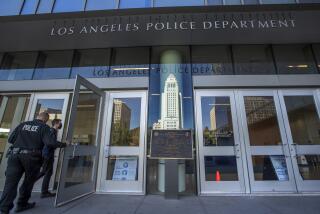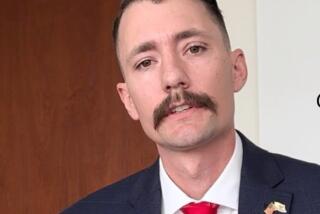No Charges Against Officer : Balboa Ordered to Trial in Police Assault Case
- Share via
Acknowledging problems with conflicting witness accounts of a controversial police shooting, a Municipal Court judge Friday ordered George Edward Balboa to stand trial on a charge of assaulting a San Diego police officer with a deadly weapon.
Judge Robert J. Cooney said that, depending on what set of facts a jury might choose to believe, Balboa could just as easily be acquitted as convicted of assaulting Officer Stephen Williamson with a metal piece from a broken light bar off a police car.
But Cooney decided not to lower the $25,000 bail set in the case after the prosecutor told him that drug tests revealed that Balboa, who was shot twice by the police officer, had a high level of PCP in his system at the time of the shooting. Balboa was hospitalized for two weeks, then transferred to County Jail, where he remains in custody.
In addition, Deputy Dist. Atty. Hugh McManis said that his office will formally announce next week its decision not to press any charges against Williamson, who witnesses allege shot Balboa at point-blank range without provocation.
In his first public account of the March 23 incident, Williamson testified Friday that he shot Balboa after the man came after him with a chrome bar from his car’s overhead emergency light. The incident, which occurred around 9 p.m., marked the third shooting involving Williamson during his five-year career.
“I don’t remember pulling my gun,” said Williamson, 31, who has been placed on paid leave and is undergoing psychiatric treatment. “I shot once and the bullet hit him in the left side. He looked back at me and said, ‘Why did you do that?’ He didn’t even take a step back . . .
“I remember thinking something was wrong with my gun. I shot two more times. He didn’t bounce back again. He just stood there. . . . I go, ‘How many times do I have to
shoot this man?’ I was hoping he would just play dead and call it quits.”
Williamson said that Balboa finally fell to his knees. He then kicked Balboa down before arresting him. Another officer, who had arrived seconds after the shooting, assisted in the arrest.
All four defense witnesses who appeared at the preliminary hearing, however, disputed Williamson’s account of the shooting.
Three neighbors and Balboa’s wife testified that Balboa did not approach Williamson in a threatening manner and that he was not holding a chrome bar or anything else in his hands before he was shot.
“I saw (Williamson) back away, pull out his gun . . . and all of a sudden he shot him,” said Teodoro Velazco, who was watching from his living room. Velazco said he immediately thought to himself, “(Balboa) hasn’t done anything. He is not a criminal. Why is he shooting him?”
Cooney said that such conflicting accounts by witnesses are not unusual.
“The witnesses corroborate the officer in some respects and contradict him in others,” Cooney said. “I have found that to be the case on many occasions.”
The Superior Court judge added that the presence of PCP or any other narcotics in Balboa’s system would “shake the testimony of a whole lot of witnesses.”
McManis informed the judge that blood tests showed Balboa had a “very high degree” of PCP in him at the time of the shooting. He added that Balboa had been charged with being under the influence of PCP a month before the shooting.
Teresa Balboa began to cry on the witness stand when she admitted under questioning by McManis that she had seen her husband drunk on numerous occasions. She said her husband was a former heroin addict and that he had beaten her.
Balboa’s defense attorney, Deborah Carson, said that Williamson’s unstable police work during the last five years will play a crucial role in the outcome of her client’s trial, which is scheduled to begin in late summer.
“I’m not discounting PCP as an important factor,” Carson said. “Whether he had PCP in his bloodstream is not indicative one way or another if he is acting under the influence . . .
“Based on what we know about Officer Williamson’s background, I am leery of his perceptions.”
The Times reported last month, based on internal police memos, that Williamson has had a troubled law enforcement career. He became “unreasonable” and overzealous in enforcing prostitution laws, was suspended for missing three court dates and had trouble controlling his temper, according to the memos.
In 1983, Williamson’s field supervisor, Sgt. Richard DeParis, wrote that Williamson “is having severe difficulty coping with field situations and poses a potential hazard to both the community and fellow officers due to his erratic behavior.”
Despite the warning by DeParis, police officials did not take the officer off the street until August, when Williamson complained of a job-related injury to his “psyche.” The injury stemmed from a 1981 incident in which Williamson accidentally shot and killed an innocent bystander.
Williamson was ordered to return to full duty in October. Within a month, he shot a fleeing suspect in the back of the leg. Authorities later ruled the shooting justified. Four months later, Williamson shot Balboa.
During his testimony Friday, Williamson could not remember numerous details surrounding the March shooting, including what type of clothing Balboa was wearing and whether he used one hand or two to grip his service revolver.
Williamson said he thought Balboa was “a little retarded” when the man initially approached him at a Logan Heights intersection. Williamson had stopped his patrol car to repair his overhead emergency lights.
The officer said Balboa did not threaten him during three separate conversations that took place within several minutes after he stopped for the repairs. But when they met a fourth time, Balboa turned into a completely different person, Williamson said.
“He was agitated,” Williamson said. “He became violent, mad. He was rigid . . . his skin, muscles, veins, everything was popping. His fists were clenched. . . . I realized the man was more than likely on PCP.”
Williamson said that Balboa repeatedly demanded that he hand over his police badge.
Each of the four witnesses who testified Friday said they did not observe Balboa clench his fists, ask for Williamson’s badge or behave abnormally.
Williamson said he retrieved his night stick from his patrol car, but decided against using it on Balboa.
“People on PCP . . . they don’t feel pain,” Williamson said.
The officer said that Balboa came after him, began pawing at his shirt in an attempt to get his badge, and grabbed his wrist.
“I was afraid if he hooked onto my arm I would not be able to get away,” Williamson said. “ . . . He came up with this metal bar. I didn’t realize at the time that this was a piece of my light bar. . . . He’s shaking it and continues to walk toward me.”
Defense witnesses said they did not see any objects in Balboa’s hands.
Williamson said he repeatedly warned Balboa to back off.
“I’m thinking this guy is so shermed he doesn’t even know what he’s doing,” Williamson said. “This guy is going to embed this thing into me.” (Shermed is a slang term for being high on PCP.)
Williamson said he fired one shot, then waited for Balboa to fall. When Balboa remained standing, he fired twice more. Two of the shots struck Balboa.
Witnesses confirmed that Balboa did not fall back when he was shot, but said that the three shots were fired in rapid succession.
Once Balboa was on the ground, Williamson said, he had to forcibly remove the light bar from the man’s left hand with the assistance of two other officers.
Officer Kathen Caddy testified that, when he arrived, Balboa was lying on his back and waving his arms in the air. Caddy said he did not see the light bar until he and Williamson turned Balboa over on his stomach. He said that Williamson then pulled the bar out of Balboa’s hand.
More to Read
Sign up for Essential California
The most important California stories and recommendations in your inbox every morning.
You may occasionally receive promotional content from the Los Angeles Times.










